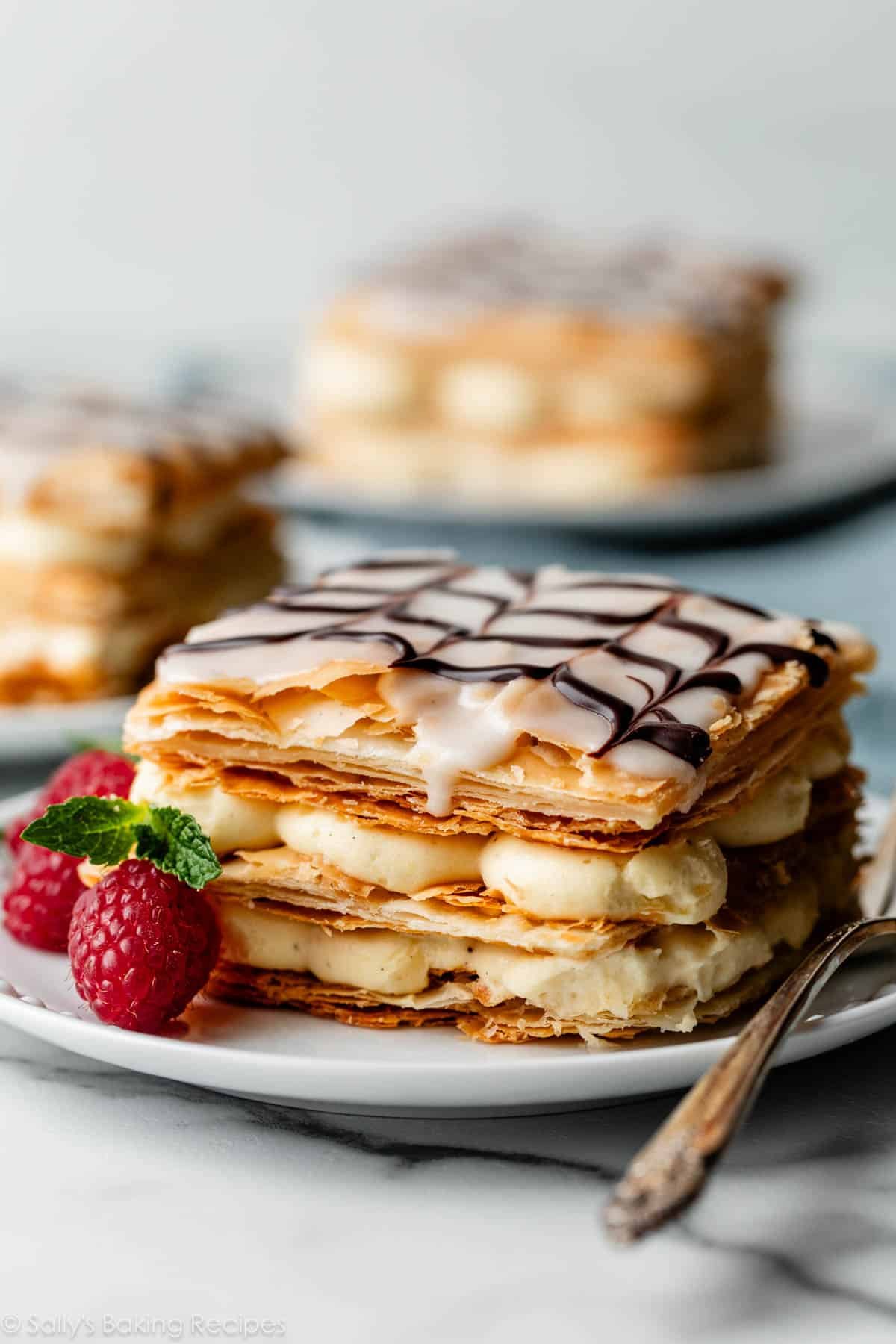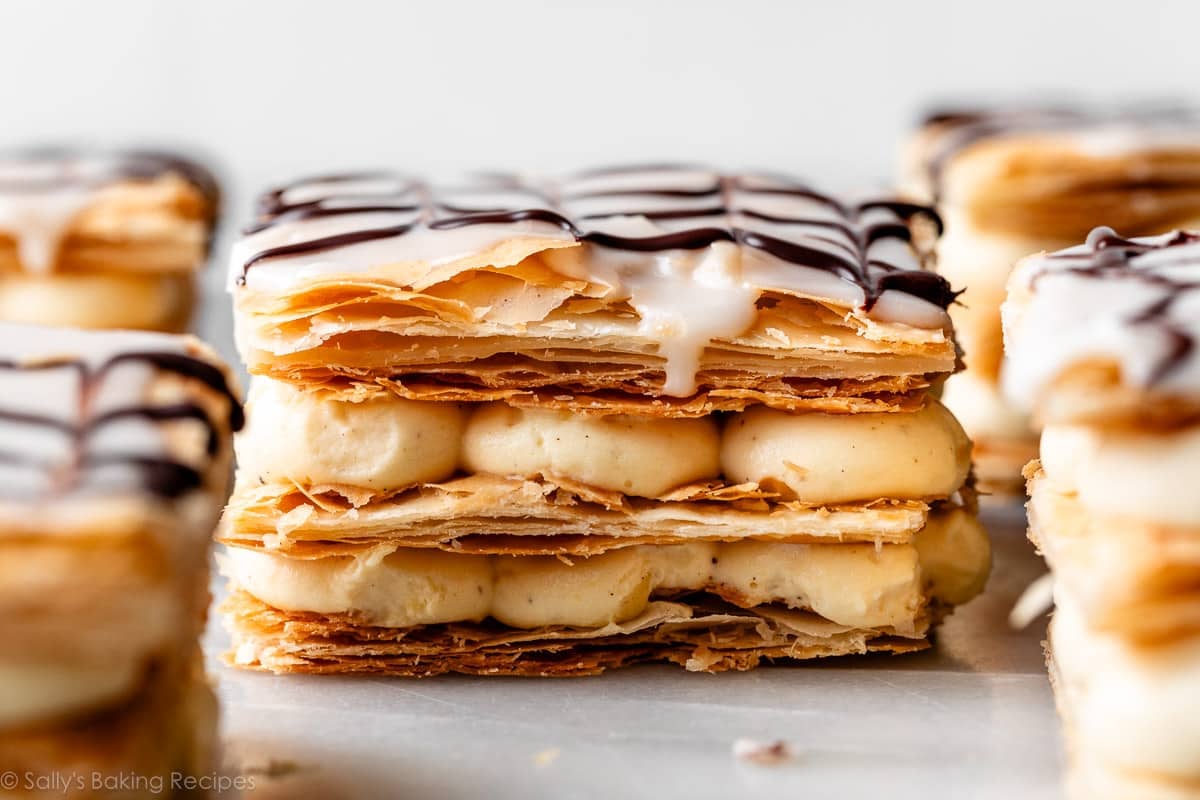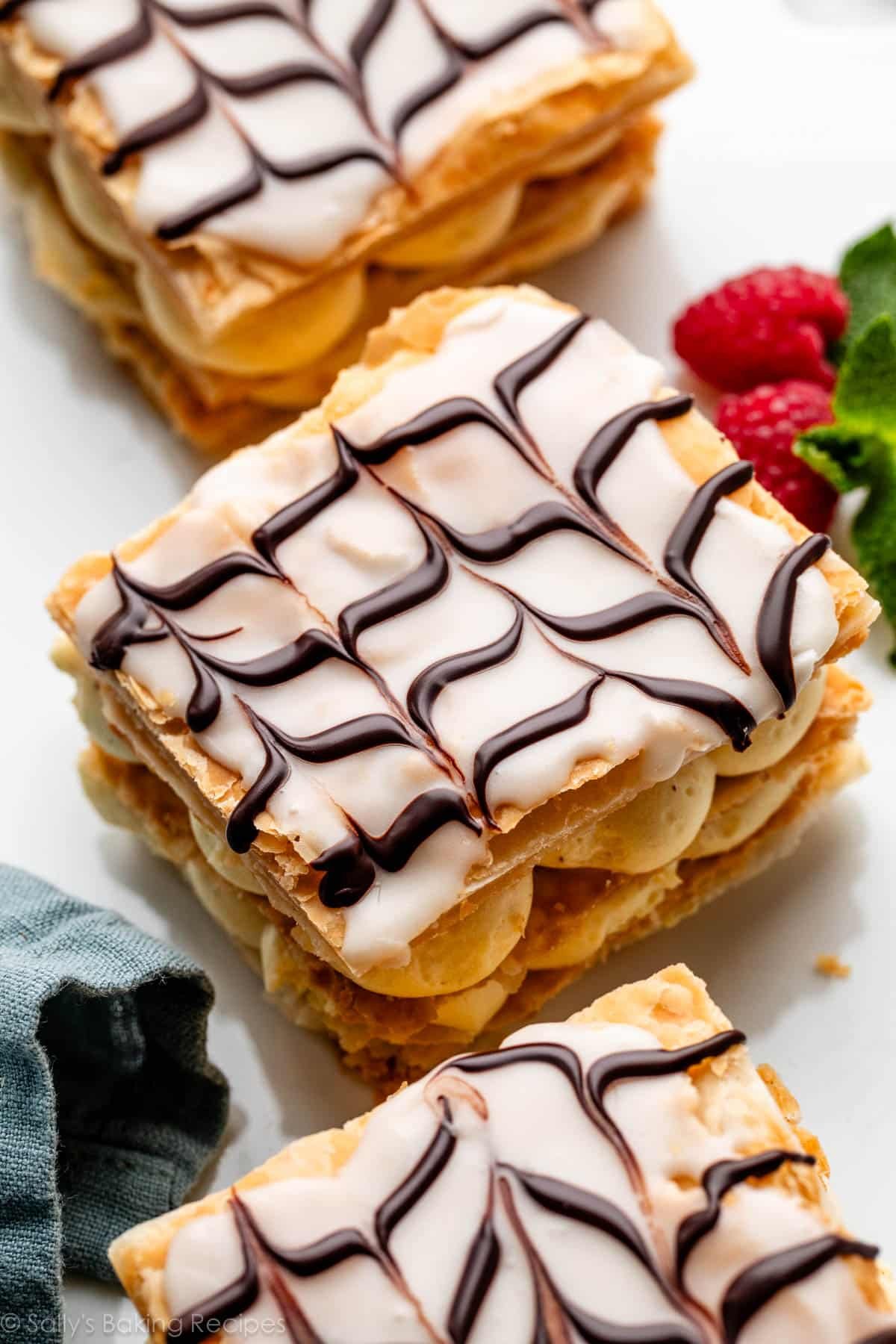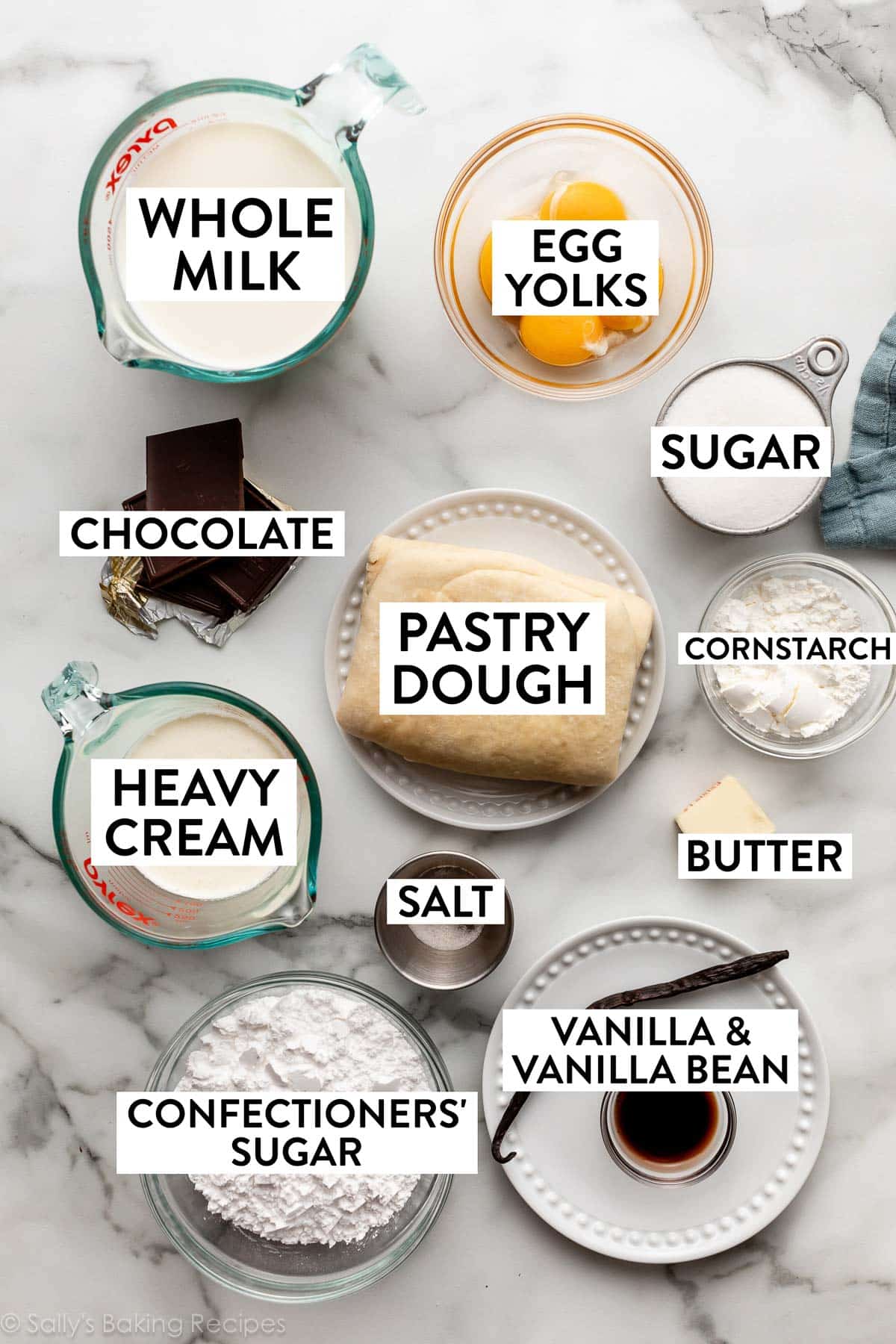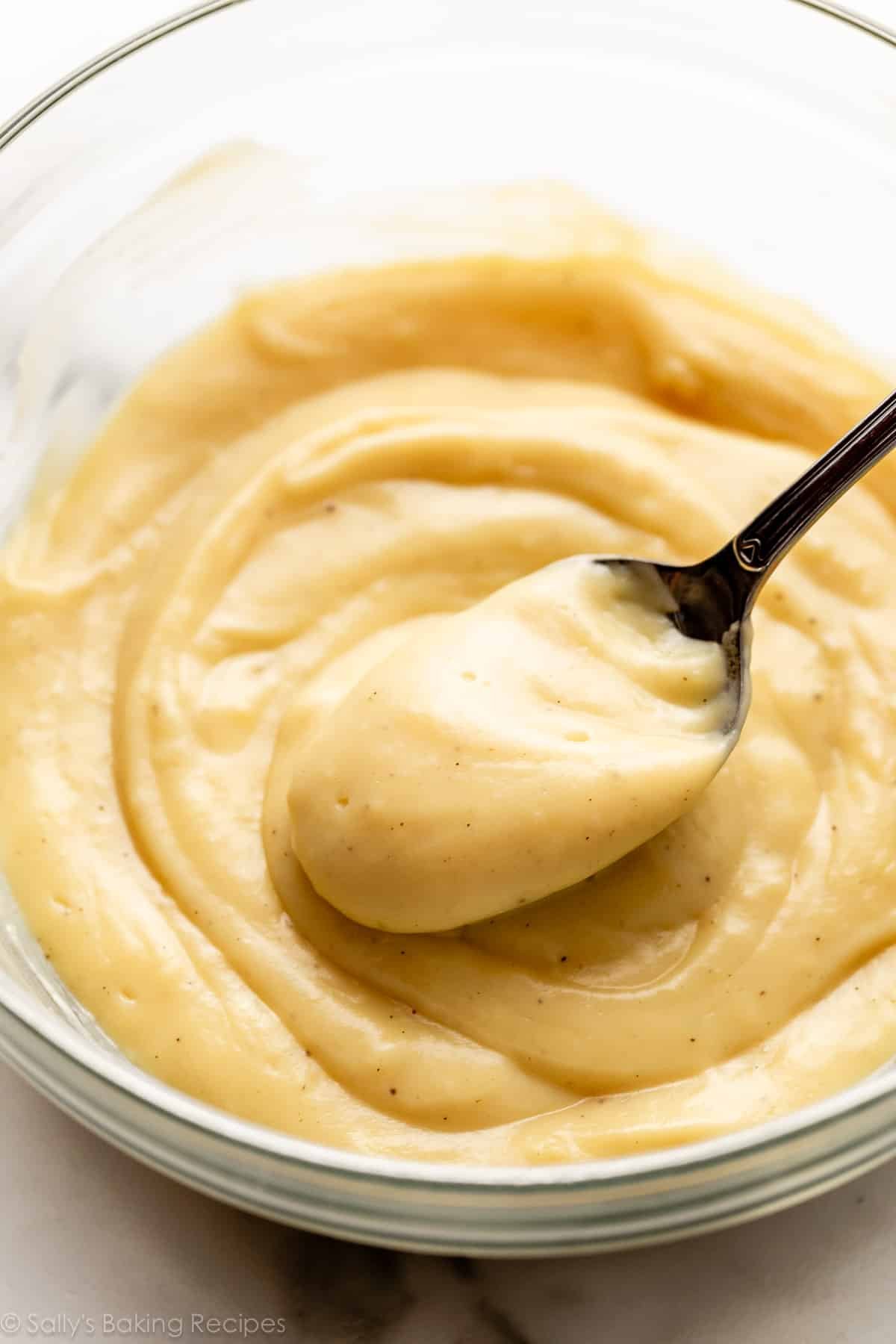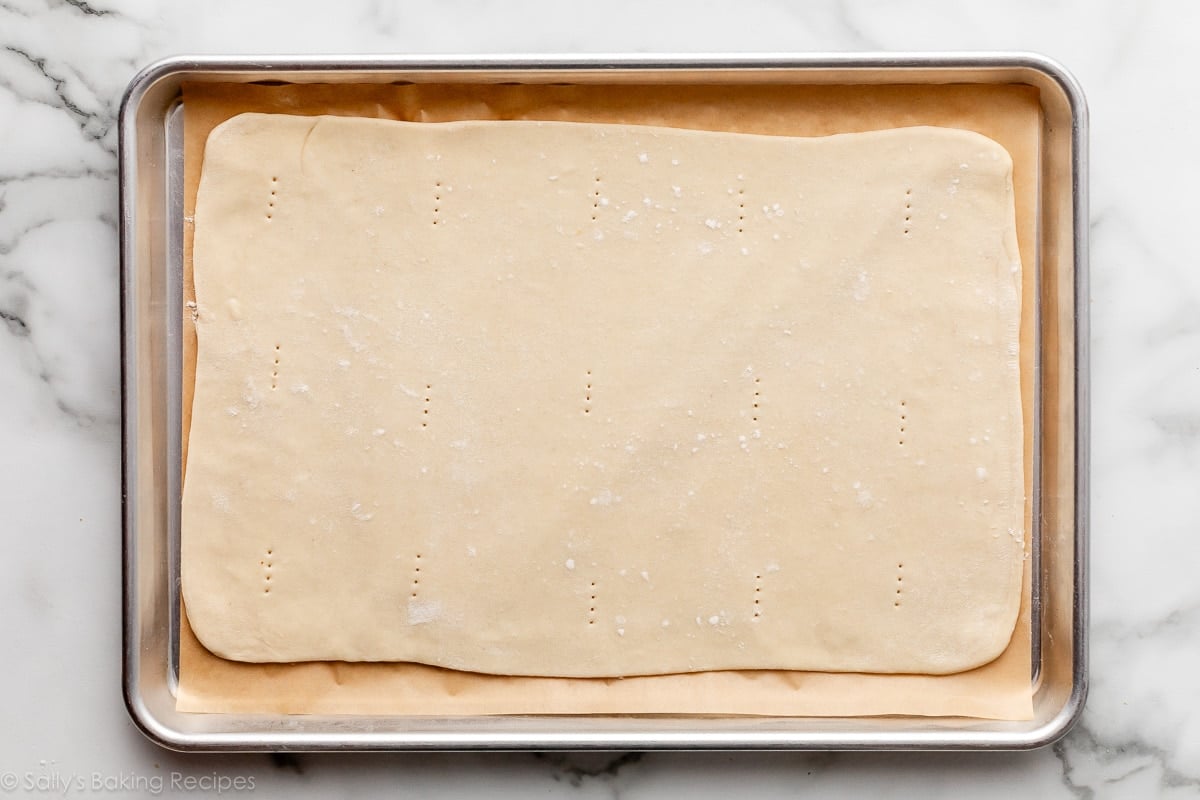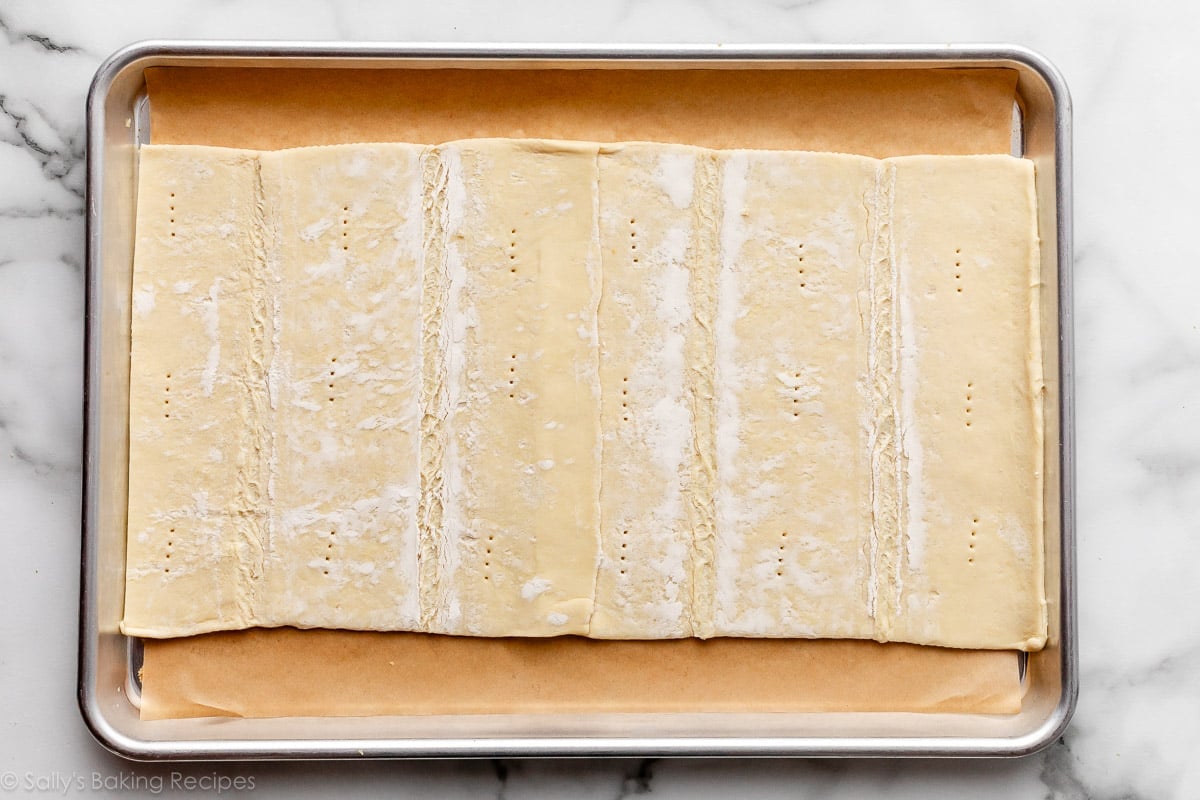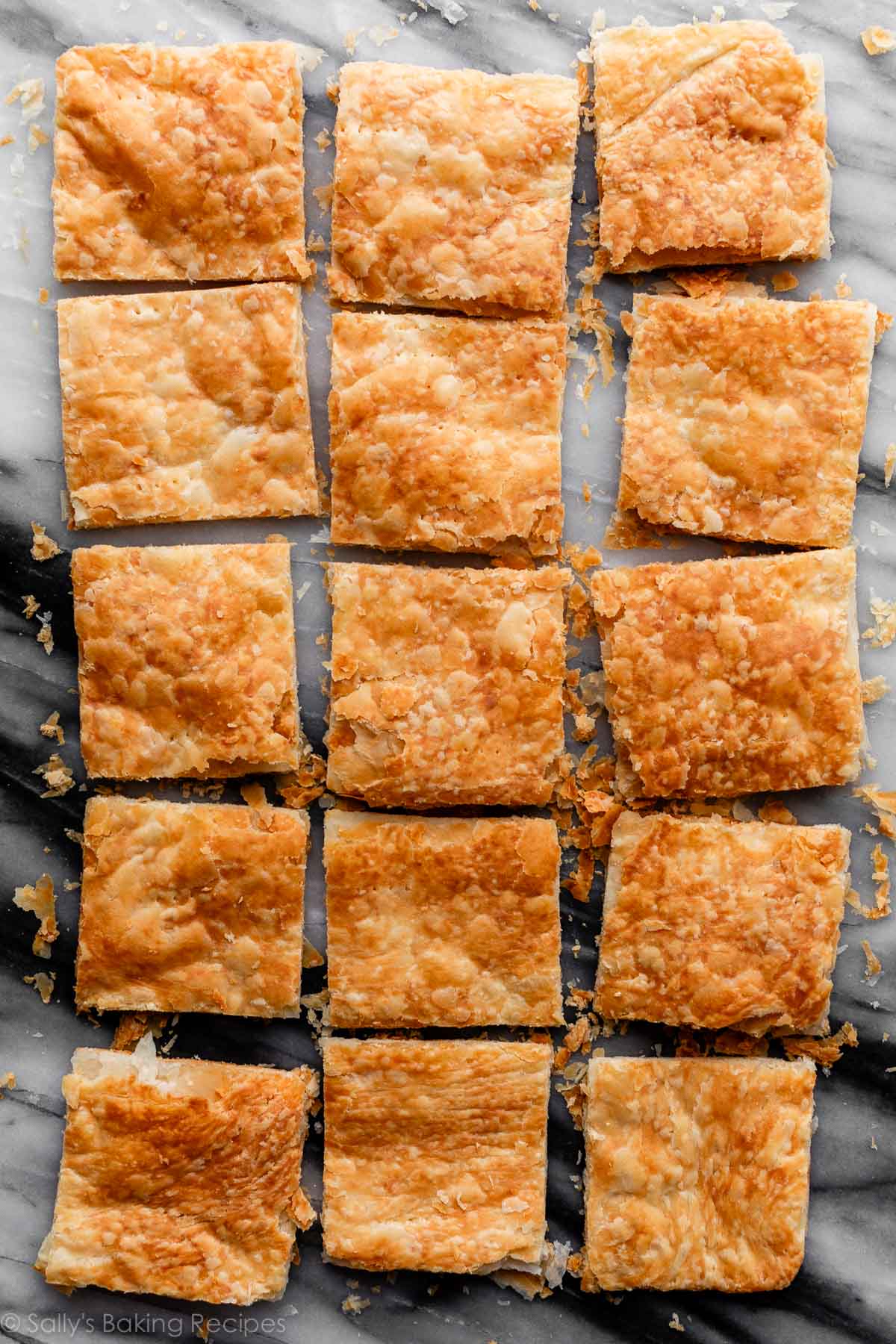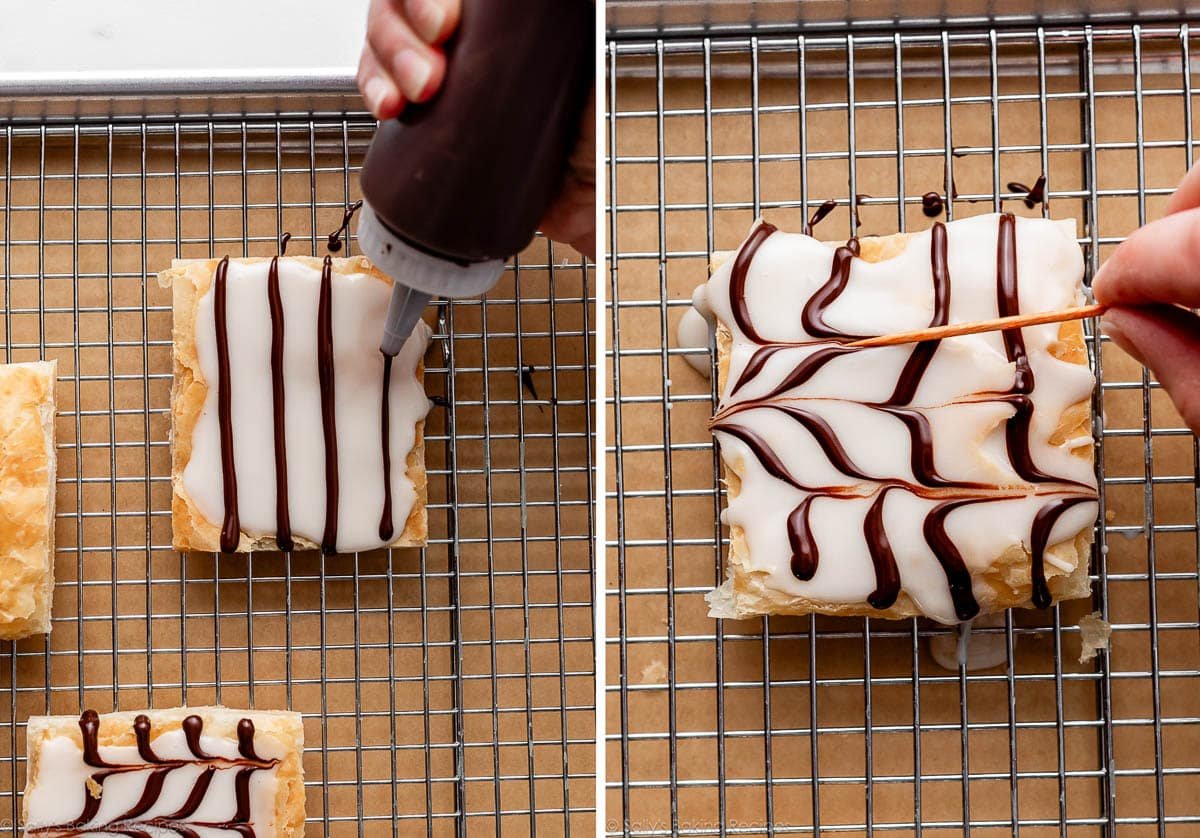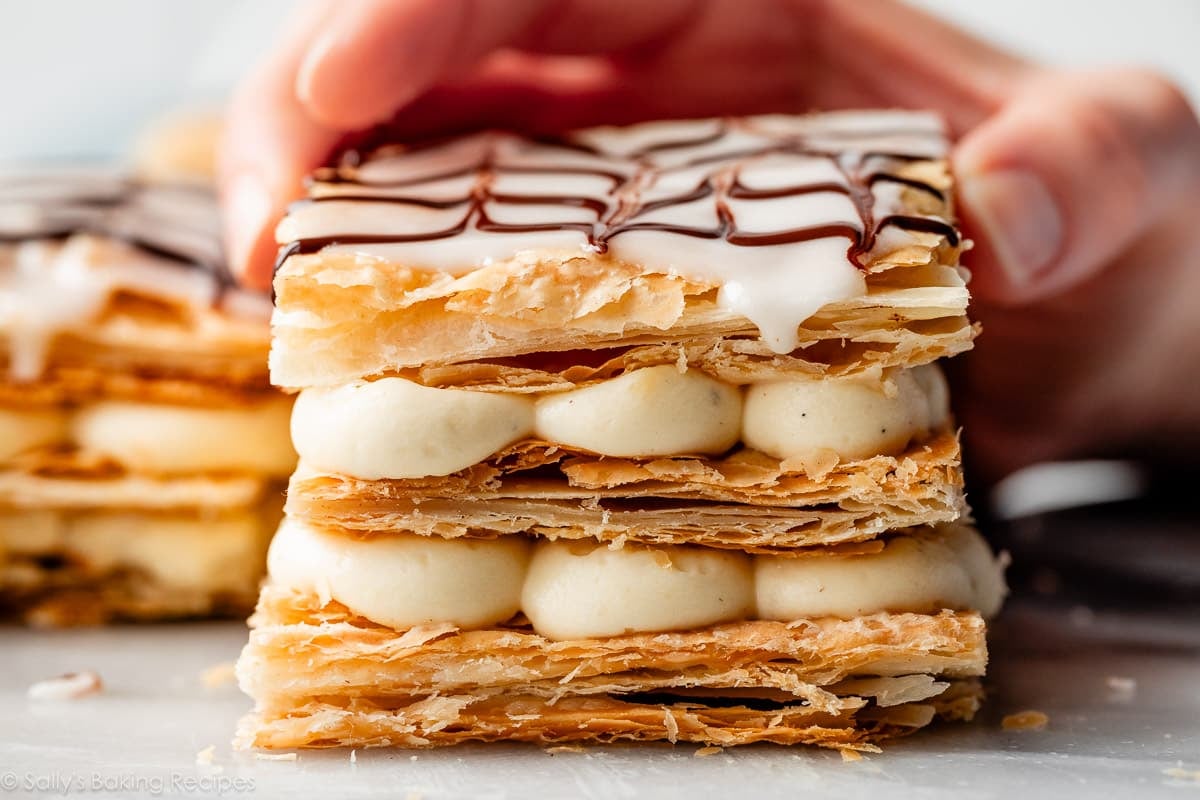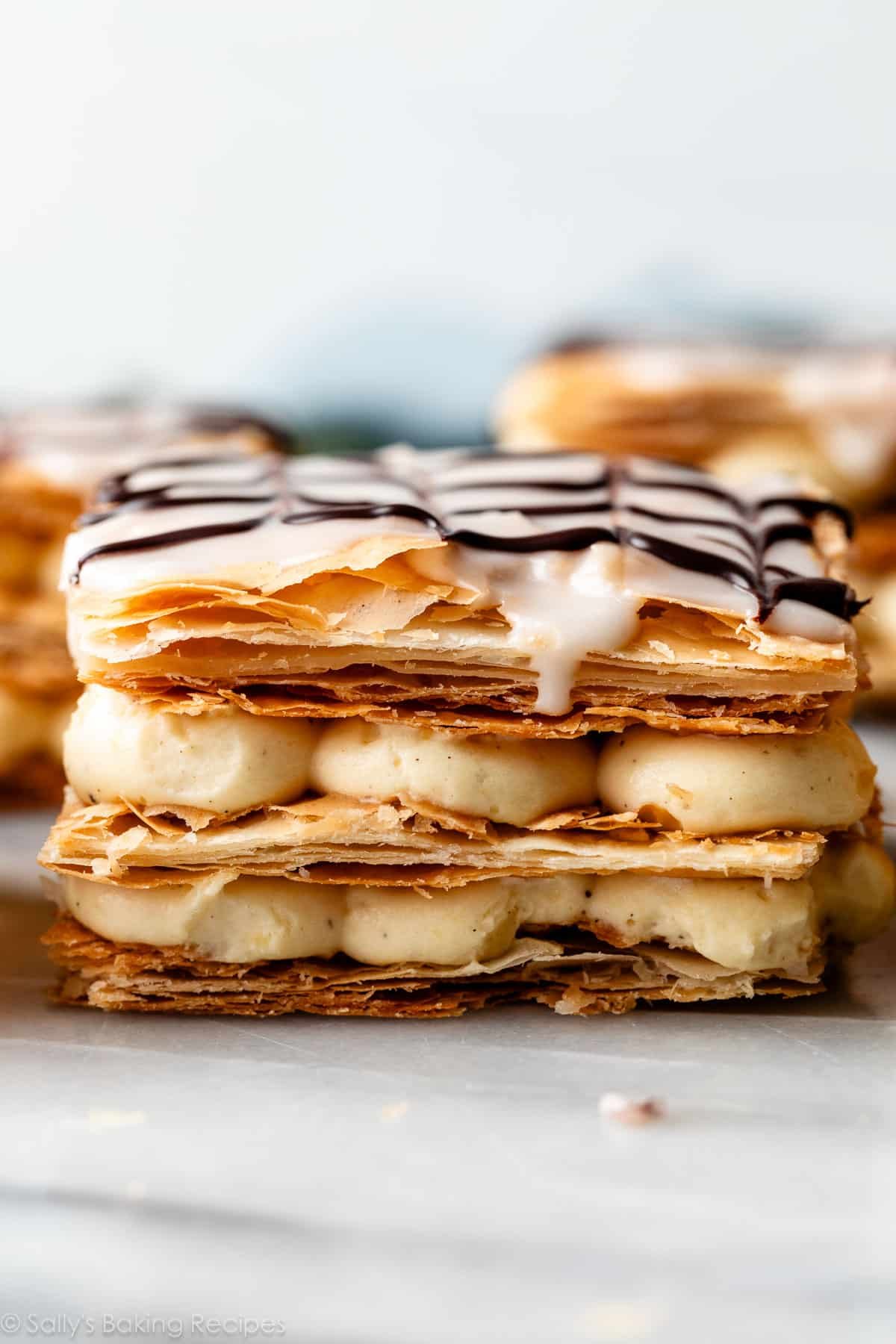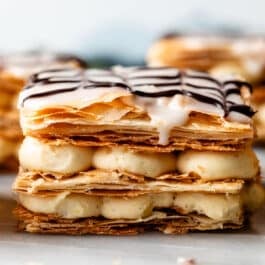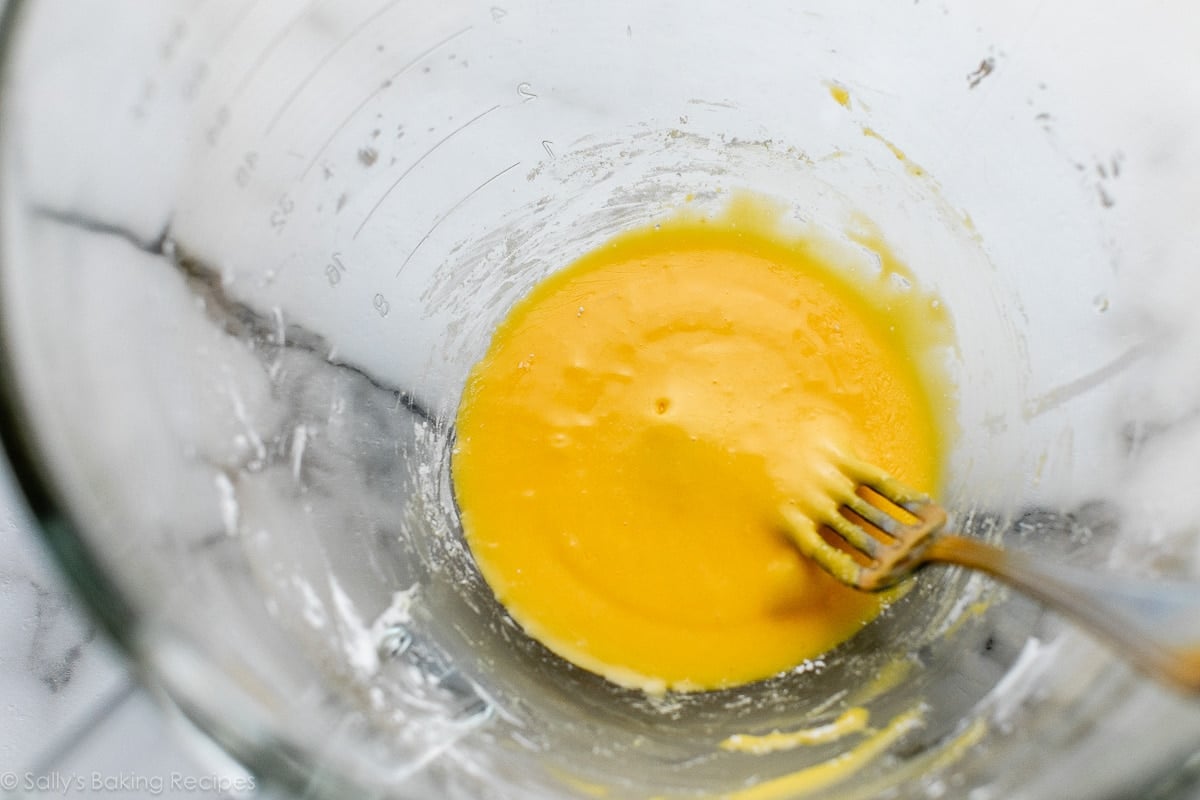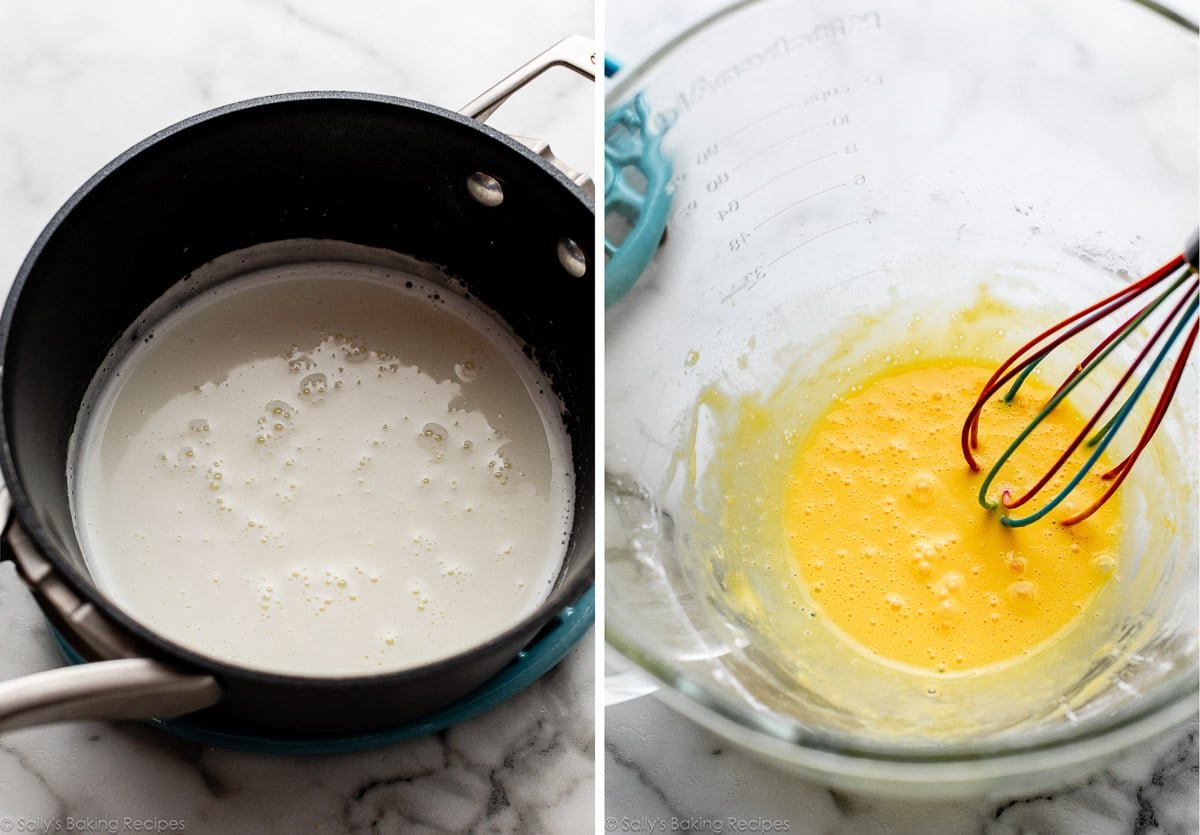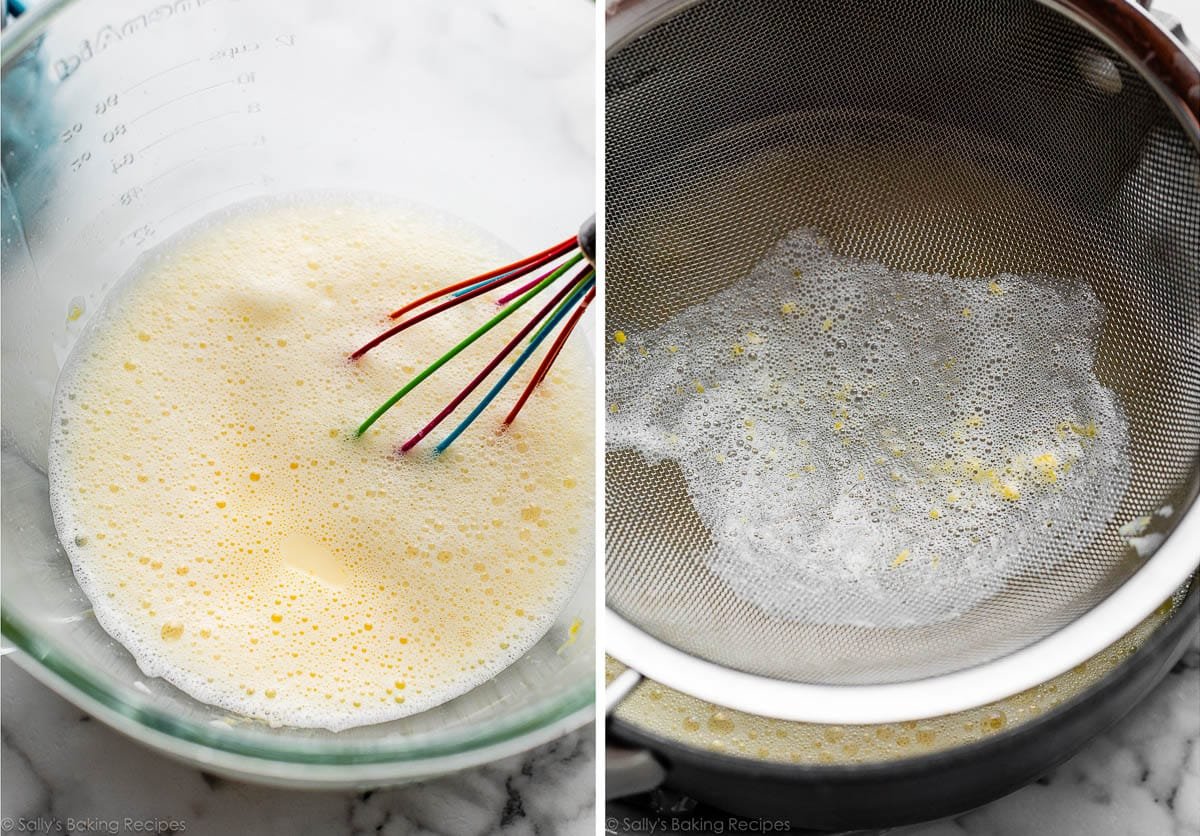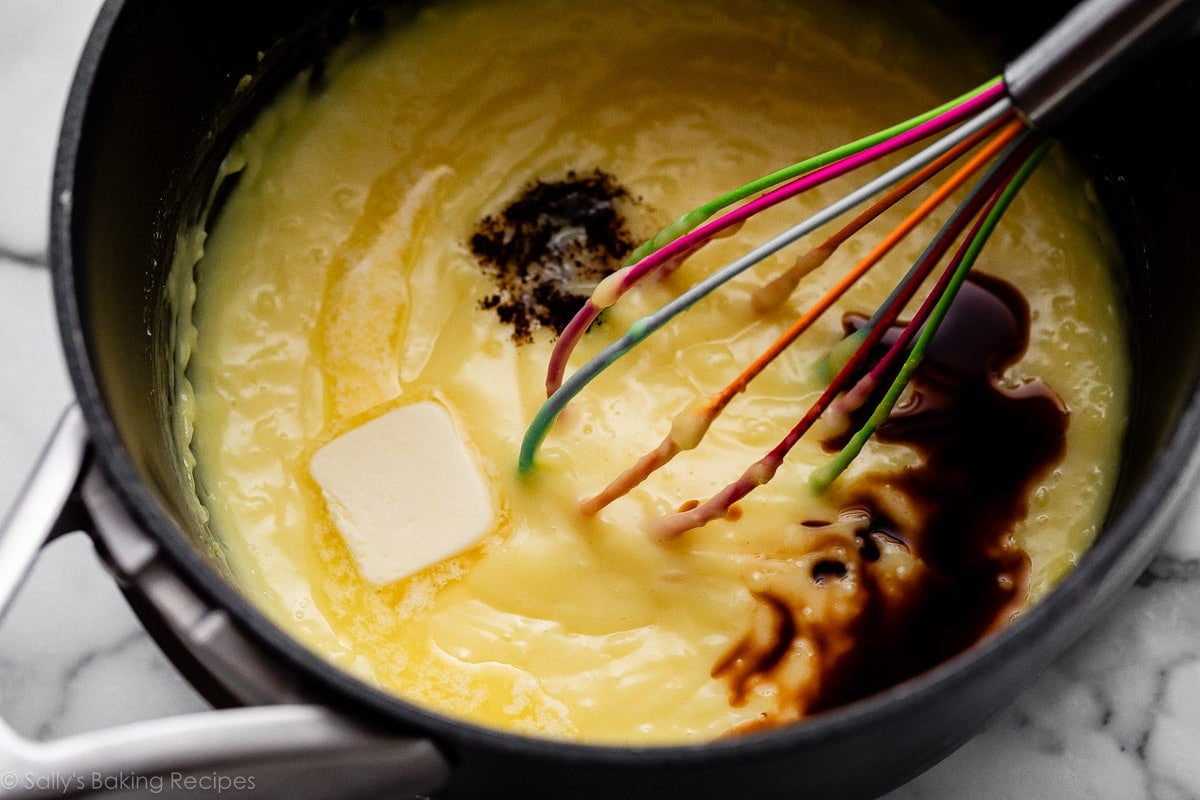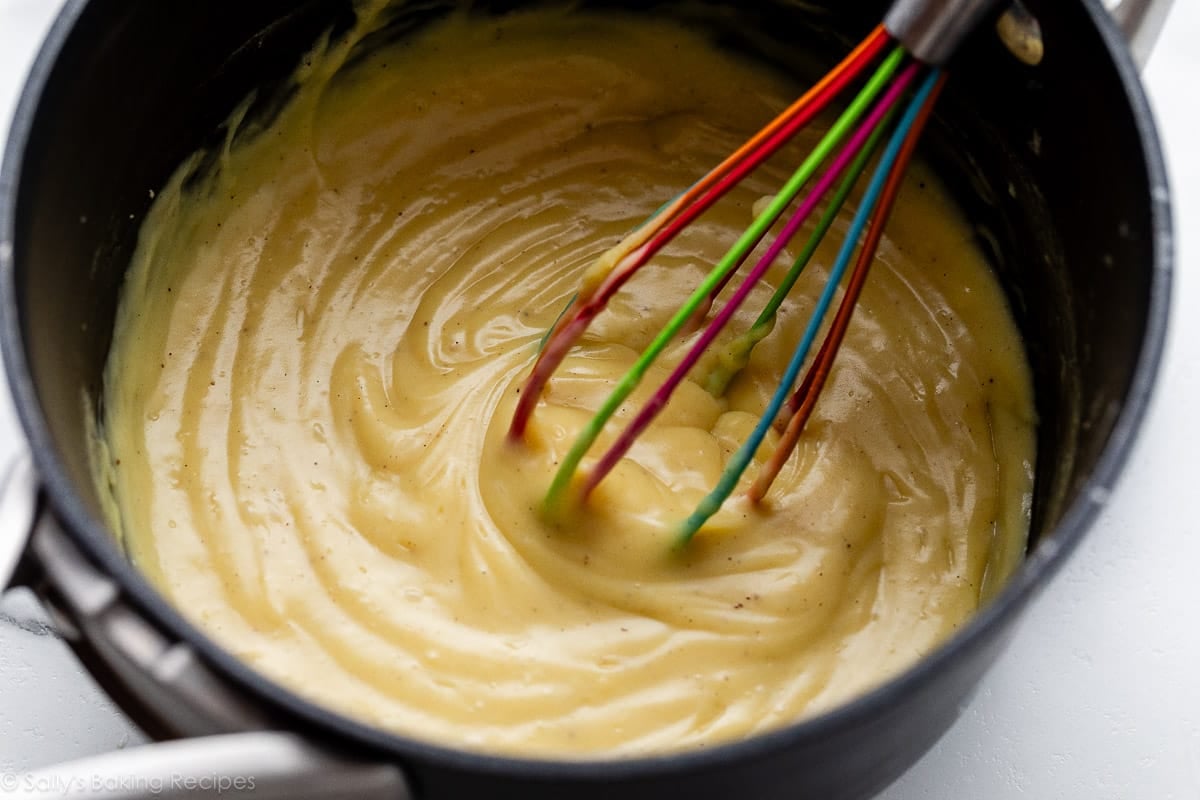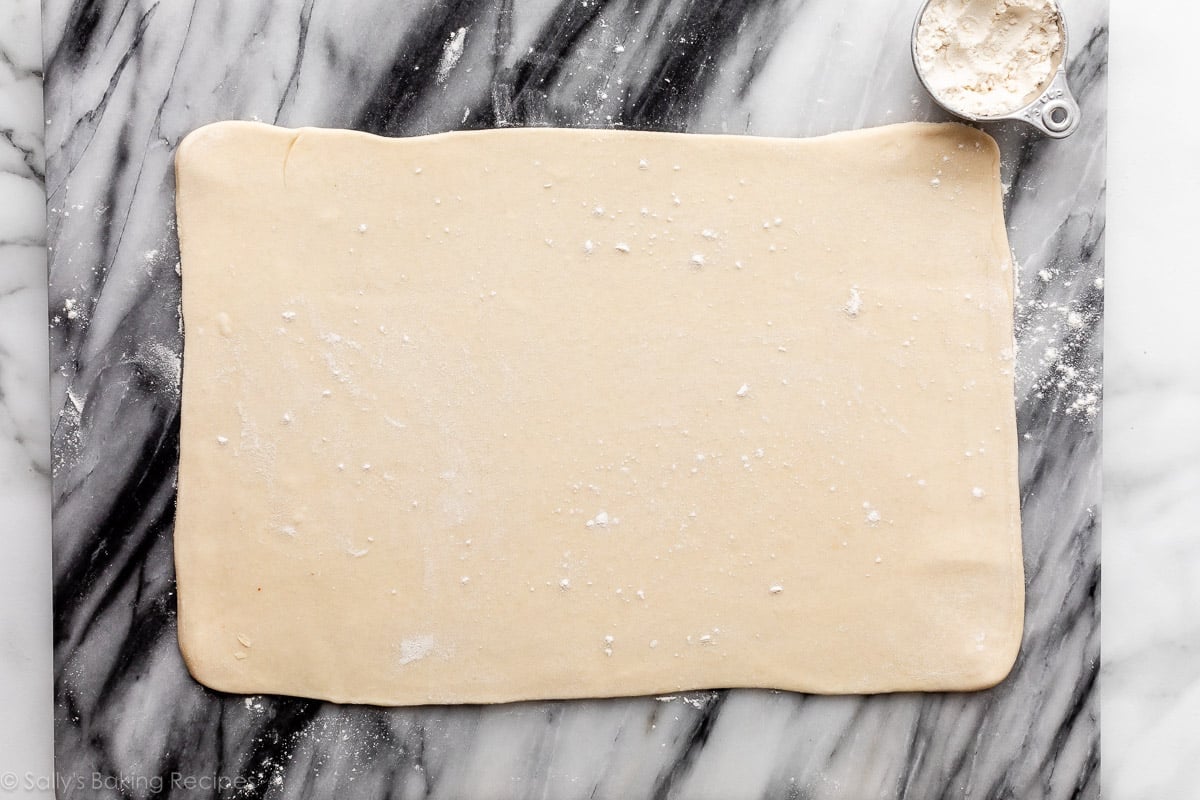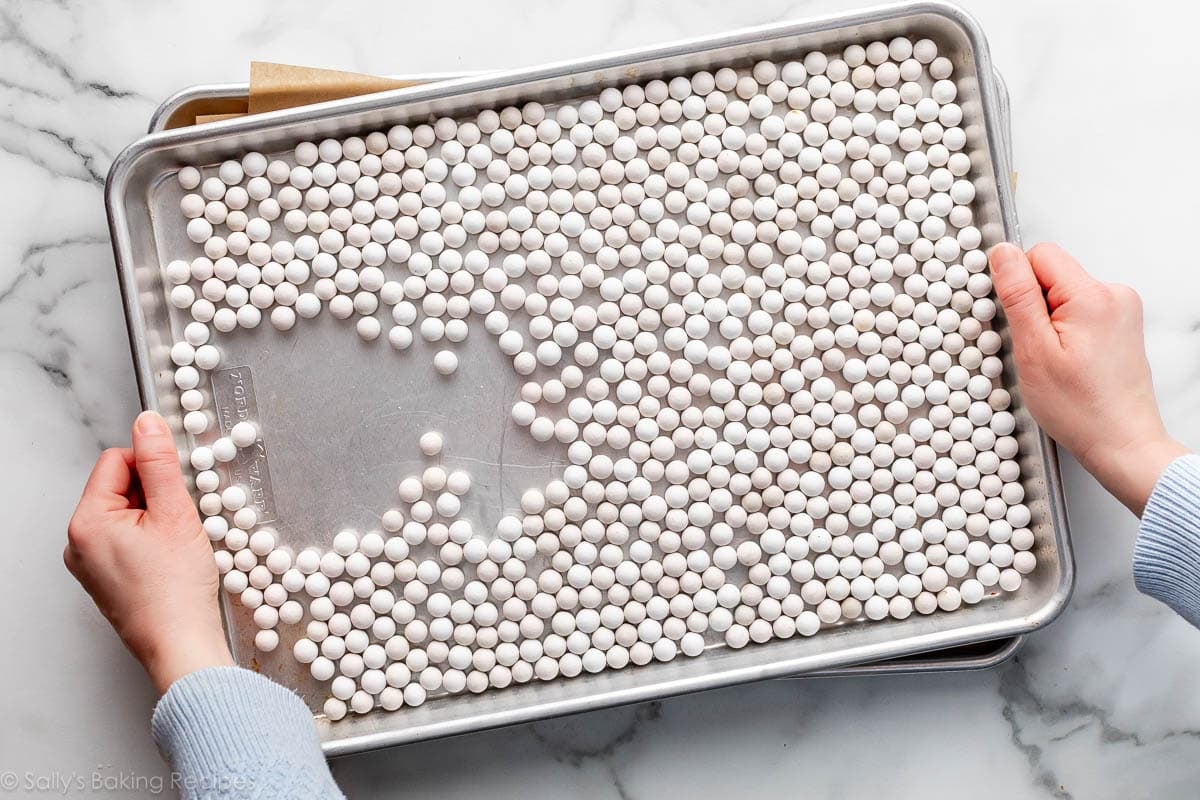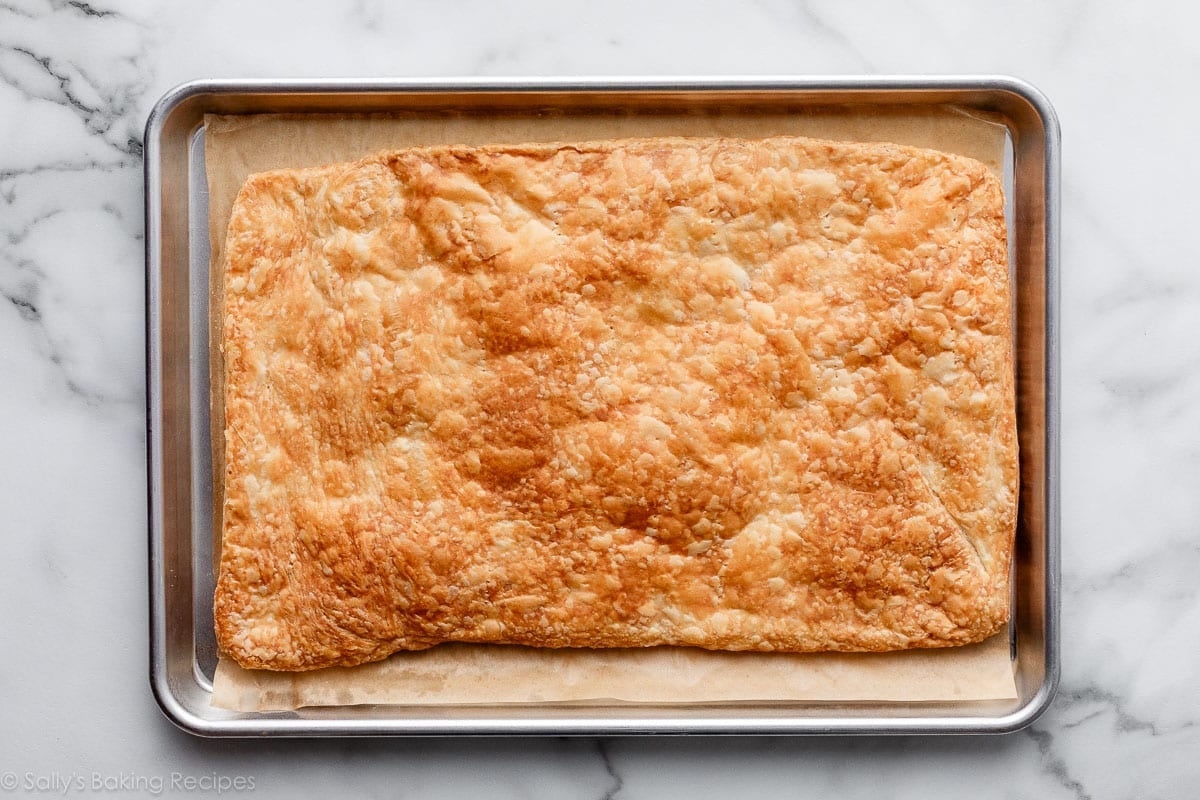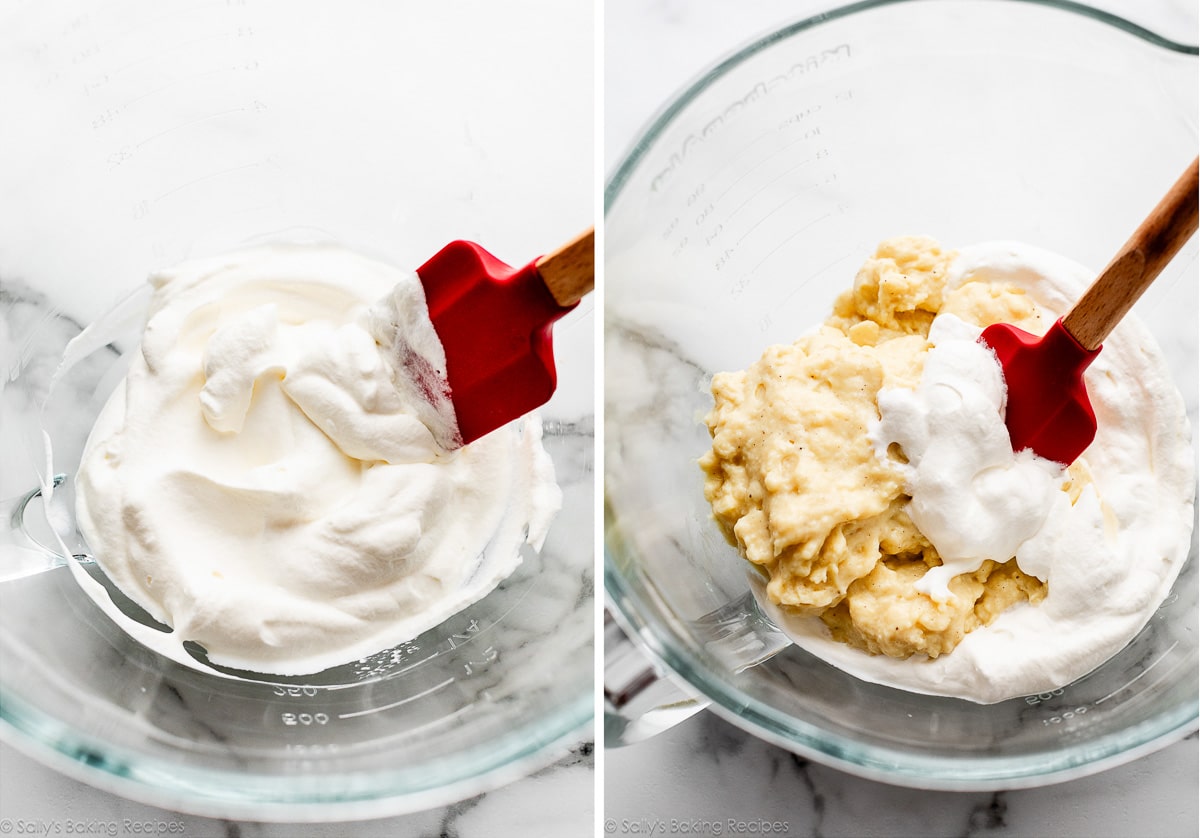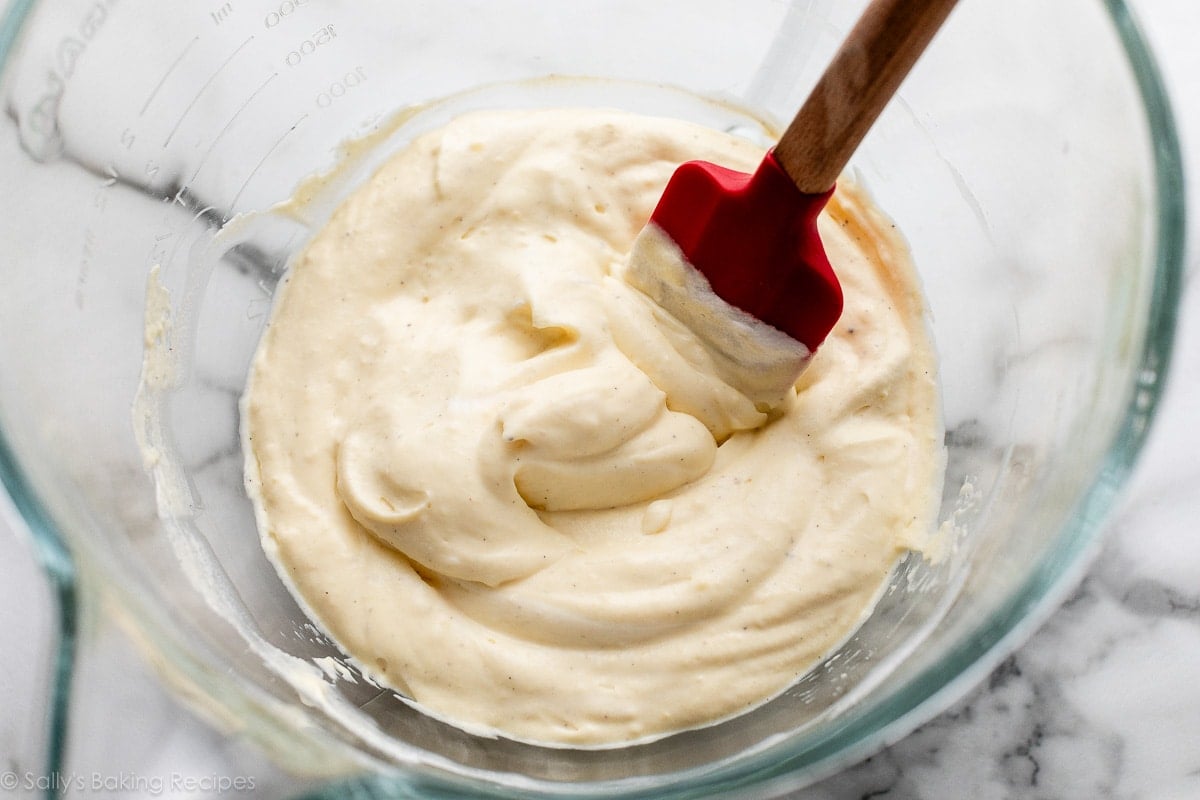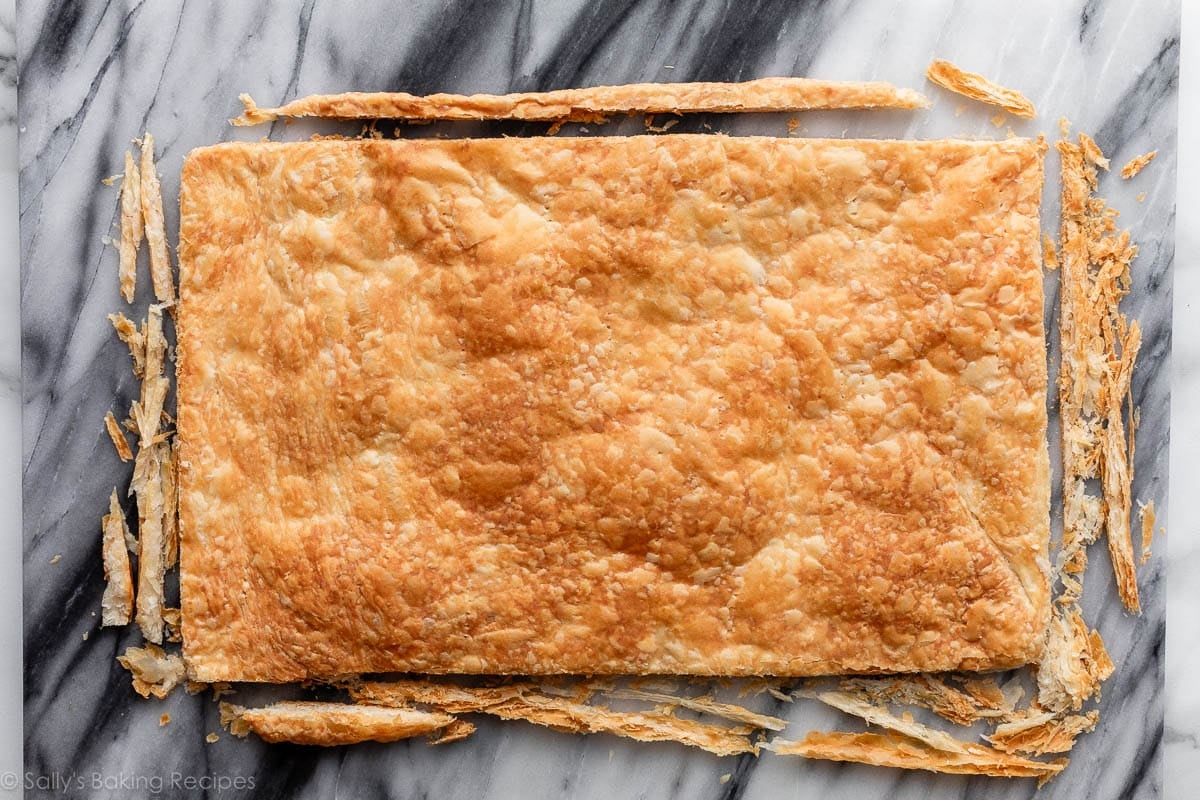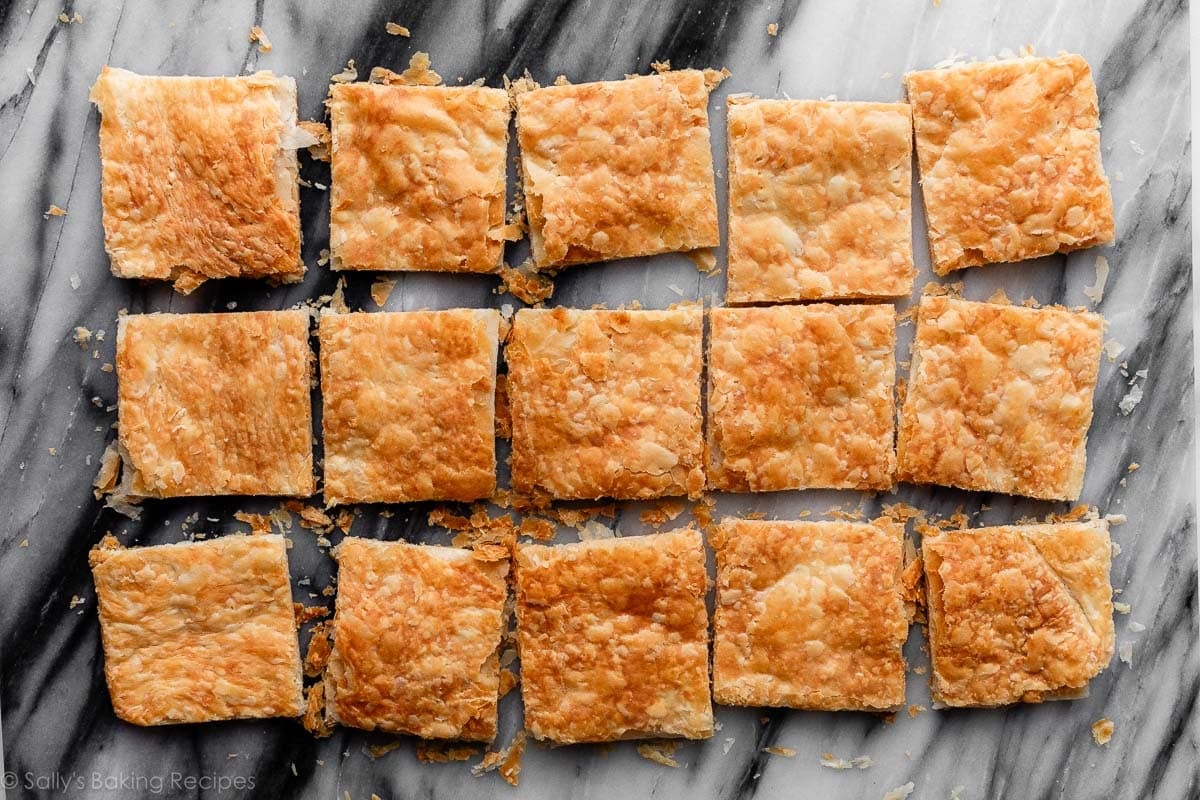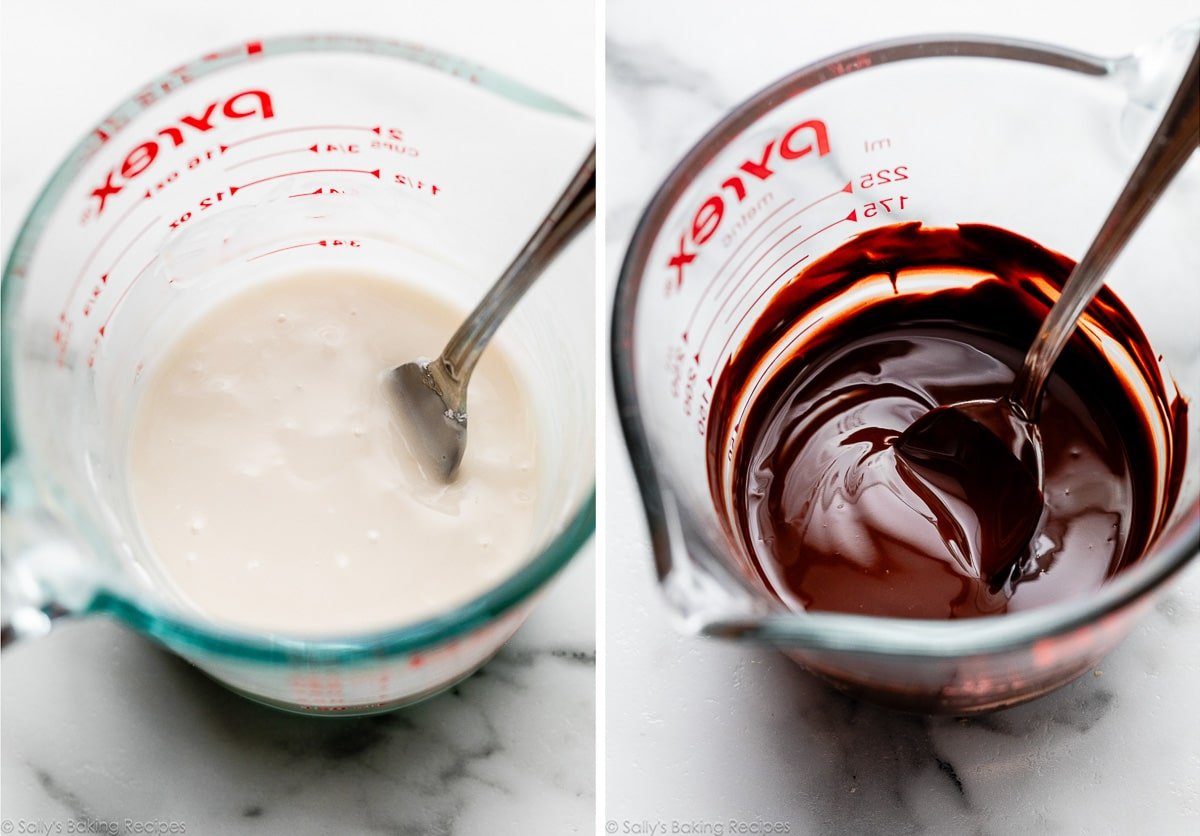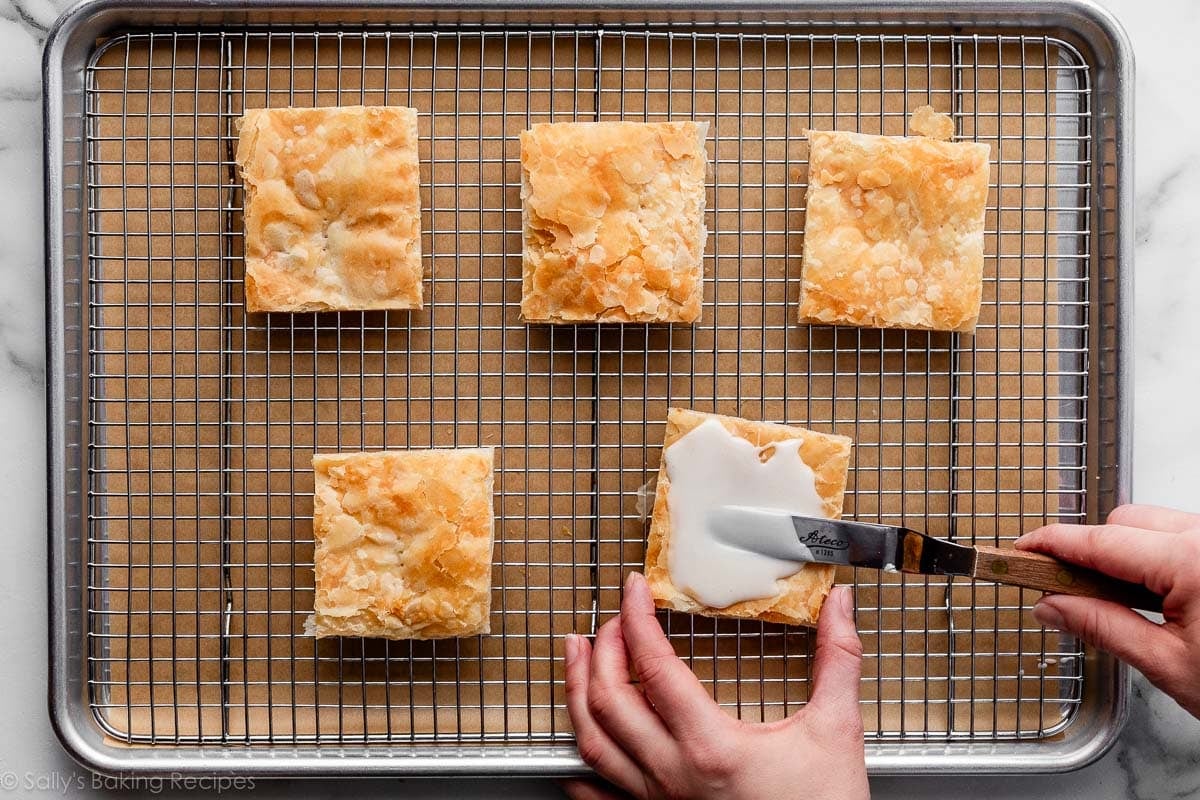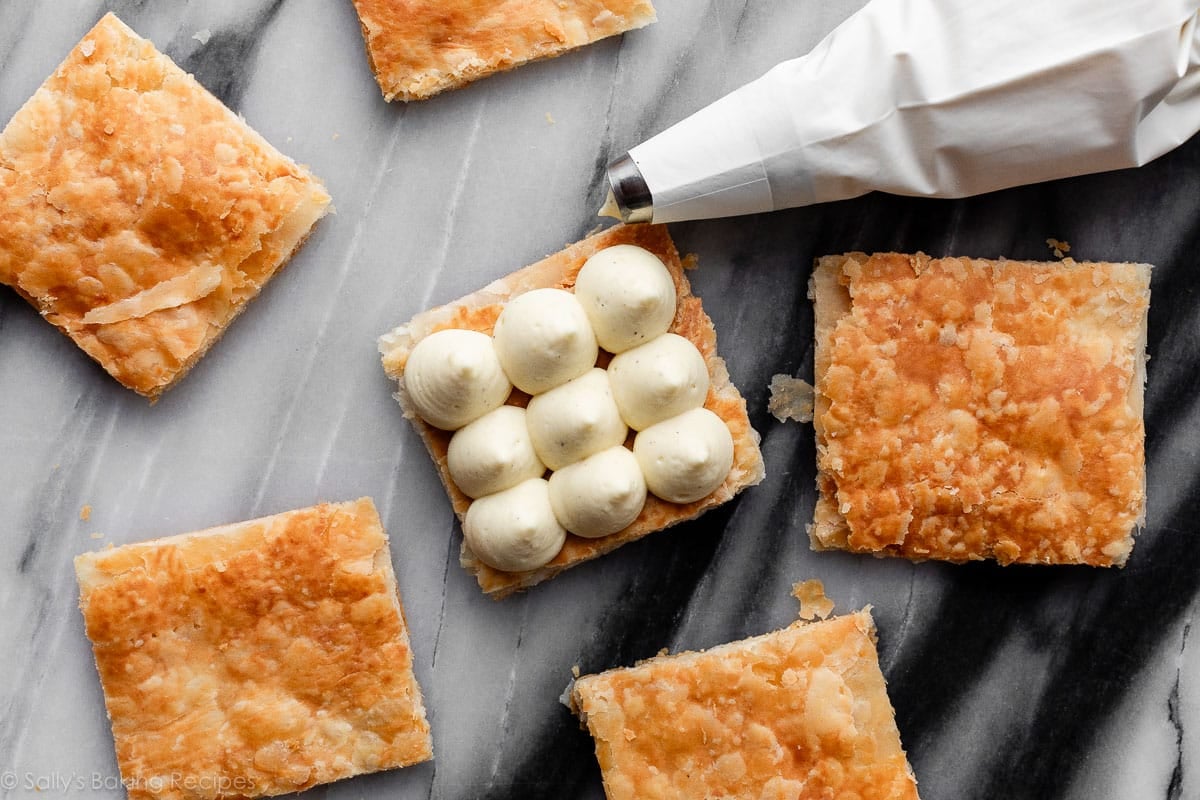Ready to majorly impress yourself and anyone lucky enough to be a taste tester? Let’s make an ornate-looking (but totally approachable) pastry dessert.
What Is Mille Feuille (and How Do You Pronounce It)?
The French “mille feuille” (pronounced meel foy) translates to a thousand sheets or leaves, a description of this dessert’s many whisper-thin pastry layers. It’s also sometimes called a “Napoleon” or a “custard slice” depending on the filling and/or region. (There are so many versions!) No matter what you call it, this eye-catching European pastry is an impressive sight to behold in a pâtisserie display case. I have loved poring over recipes online, including from The Spruce Eats, Erin Jeanne McDowell’s on Food52, Bake from Scratch, Preppy Kitchen’s mille feuille, and Prue Leith’s on GBBO. I set out to make my own version, using a couple of those recipes as my inspiration. And today I’m going to teach you how to make it, too. Just like with homemade croissants, it may look like a daunting baking challenge, but if you take your time with some of the technical steps, I promise it’s doable! The process does take time, but the steps can be broken up over a couple of days.
How to Make Mille-Feuille (Millefeuille or Mille Feuille)
Here is everything you need to make this recipe:
3 layers of baked puff pastry 2 layers of pastry cream 1 layer of marbled icing
Pastry Cream Filling
Let’s start with the filling because it has cooling and chilling steps involved; it’s efficient to make this first so it’s ready when the baked puff pastry layers are ready. (You can also make it a day ahead.) Pastry cream, or crème pâtissière, is a vanilla custard-like filling you can use for treats like pies, eclairs, doughnuts, and more. You cook it on the stove just like you prepare the pudding filling for banana cream pie. It’s quite thick after chilling, so you usually need to give it a stir to smooth it out again. In this layered mille-feuille, we actually take it a step further and add whipped cream. This considerably lightens up the texture, making it velvety-smooth—think homemade whipped cream, but richer and more substantial. When you add whipped cream to pastry cream, I learned, it’s called crème légère, or lightened cream. (It can also be called diplomat cream or crème diplomate, but that sometimes includes gelatin.) If you’ve ever made Boston cream pie, you’re familiar with pastry cream. I deviated from that recipe, though. It’s a cake filling there, so it’s really sturdy and thick. I needed less pastry cream, and I wanted a lighter consistency for this dessert’s filling. The detailed instructions and step photos are in the recipe below, but let me share some key steps and success tips so you have a better understanding.
Cornstarch and egg yolks thicken the cream. Combine those first, and then move to the stove. You’ll simmer whole milk and granulated sugar together, and then remove it from heat and temper the egg yolks. Tempering is important here. To temper, slowly pour the hot milk mixture into the egg yolks and cornstarch, whisking constantly. This carefully and slowly raises the egg yolks’ temperature. The purpose of tempering is to prevent scrambling them. Strain it. Just in case there are some solids! Pour all of the mixture back into the saucepan through a fine-mesh sieve, to strain out any solids that may have formed. Bring it to a boil. At first it won’t seem like it’s thickening much, just getting frothy, but as soon as it reaches a boil with big bubbles bursting on the surface, it will thicken up pretty much immediately. Remove from heat & add flavor. Stir in butter, vanilla extract, vanilla bean + a pinch of salt.
Then you’ll need to refrigerate it so it thickens. This is the velvet-rich pastry cream before chilling: Chill it in the refrigerator for a minimum of 3 hours or overnight. It will firm up a lot during this time. Give it a stir and then combine it with whipped cream. Chill it once again for 1 hour, so it’s nice and thick for piping between the flaky pastry layers. And this is the pastry cream after combining with whipped cream:
Puff Pastry Layers
I’m using my homemade rough puff pastry, but you can absolutely take the shortcut of using store-bought puff pastry. If frozen, thaw it according to package instructions before you begin. If you’d like to make the rough puff pastry from scratch, you need just 5 ingredients: flour, sugar, salt, cold butter, and cold water. All of the same ingredients as butter pie crust, but there’s the added rolling and folding process, similar to biscuits, which gives us all of those flaky layers. Once you have your store-bought dough thawed, or the homemade dough chilled (after the second refrigeration as detailed in the rough puff pastry post), it’s time to roll it out, and you’ll find those exact instructions below in the recipe. Place the rolled-out dough on a lined baking sheet and dock it with a fork, just like you would when par-baking pie crust. This is the homemade puff pastry dough ready to bake: This is the store-bought puff pastry dough ready to bake (you’ll connect the 2 sheets that usually come in a box):
An Odd Step: Weigh It Down!
Now here’s the step not usually included in puff pastry recipes: we are going to weigh down the pastry to prevent it from puffing up too much. Place another sheet of parchment paper on top of the pastry dough, then set another baking sheet on top of that. If you have pie weights, pour them onto the top baking sheet. You could also use dried beans instead. If you don’t have either, bake it with just the (empty) top baking sheet, and when it comes out of the oven, set a pan or skillet on the top baking sheet while it cools. You’ll bake it covered with weights (or whatever you’re using) for 20 minutes, and then uncovered (without weights) for another 7–9 minutes. Note: I found that the homemade puff pastry gets much darker than the store-bought; likely because it’s made with butter instead of oil-based fats. Once the baked pastry has cooled, you’ll cut it into 15 (roughly) equally sized pieces, to make 5 mille-feuille stacks containing 3 pastry layers each. Mille-feuille are often rectangular in shape, but I found that making them as squares was easier when it came to cutting uniform-size pieces. When I tested these as rectangles, I found they were either too small and difficult to assemble, or else made 4 huge pastries that were much too large for individual portions. I had the best success with making 5 assembled 3-inch square pastries.
Top & Assemble the Mille-Feuille
There are many ways to top these, ranging from a simple dusting of confectioners’ sugar to fanciful swirls of two-toned icing. Some recipes call for royal icing, while others use fondant. I love the signature marbled icing look, so that’s what I’m demonstrating. After testing many variations, my taste testers and I determined that a thick vanilla icing + melted chocolate pairing makes for the tastiest topping. Dark, bittersweet, or semi-sweet chocolate tastes best with the sweet vanilla icing. Like I always recommend for melting chocolate, chop up a bar of baking chocolate—save the chocolate chips for chocolate chip cookies. You’ll ice all of the tops first, before assembling, because it’s difficult to ice the tops efficiently when they’re layered on top of a creamy filling. Place the 5 pastry squares you’ll use for the tops on a wire rack. With an icing spatula or a spoon, spread the vanilla icing on each square. Then pipe or drizzle melted chocolate on top. For this, I piped 4 stripes across and then used a toothpick to create the classic chevron design by dragging it in a perpendicular direction. Like this: Now let’s fill the pastries. Fit a pastry/piping bag with a large round tip, such as Ateco 808 (which I use for a lot of cupcakes—see this piping tips post). Or, you can simply use a large plastic bag and snip off a bottom corner with scissors. Start with one plain (un-iced) square of pastry and pipe on 3 dollops of cream in 3 rows, so you have a grid of 9 dollops. Place another pastry square on top of that, and then repeat the piping the same way. Finally, place one of the iced pastry layers on top. Refrigerate the assembled pastries (uncovered) for a minimum of 30 minutes before serving, just so they aren’t toppling over. Like in most pastry recipes, the refrigerator is your friend here.
How to Eat Mille-Feuille
Ahh, yes. The most difficult instruction of the day. 😉 In this step, you’ll simply stuff your face with it. But slowly! Savor and enjoy every bite. Respect the time that went into making it! Plate each mille-feuille and serve with a fork, or you can eat it handheld. The longer the assembled pastries sit in the refrigerator, the more solid they’ll become. But regardless of the time it sets, the soft filling will spill out the sides when you cut or bite into it, and that’s fine! It’s crispy, it’s creamy, it’s close-your-eyes-and-sigh dreamy.
Other Filling Options
Peanut butter mousse from my homemade eclairs recipe Whipped cream (for an extra light and barely sweetened filling) Lightly sweetened whipped frosting No-bake cheesecake filling from these cheesecake jars Chocolate mousse filling from my dark chocolate mousse cake
Or you can still use pastry cream, or any of the suggestions above, and layer your filling of choice with fresh raspberries or thinly sliced strawberries and dollops of jam. Or pipe rows of raspberry cake filling between rows of your choice of cream/mousse filling. Lots of options!
Some Special Tools You Need
Sieve Rolling pin Half sheet pans (12×17-inch baking sheets) Pie weights, but you can get around not having these! Electric mixer (handheld or stand) Squeeze bottle or pastry bag, a larger round tip like Ateco 808, or plastic sandwich & gallon-size bags with corner cut off for piping
